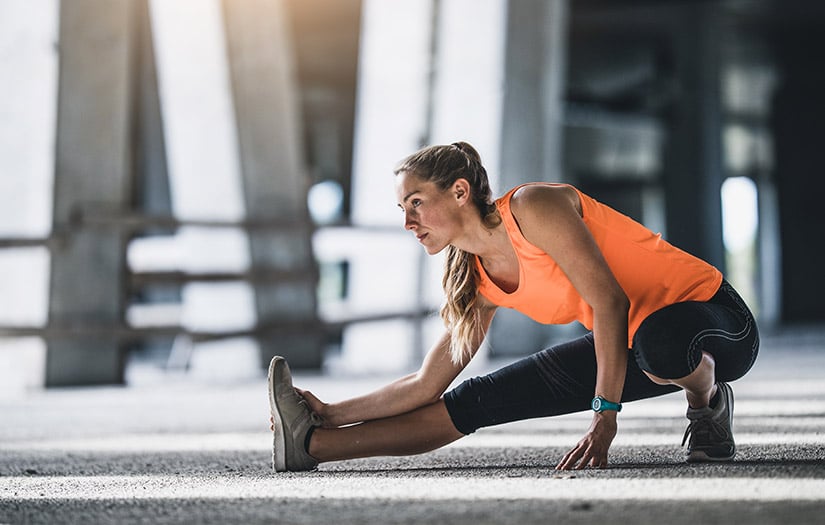Whether you're preparing for an athletic competition or a weekend pick-up game, the way that you prepare your body for training or competition can make or break your performance. While it's tempting to just jump into play after a couple of quick stretches (or not), performing a simple set of dynamic stretches can set you up for improved performance and a reduced risk of injury.
In this article, learn more about why you should consider doing a dynamic warm-up before hitting the court, field, or gym, and snag a routine to try out for yourself. These are essential concepts for sports performance professionals to know.
What is a Dynamic Warm-up?
A dynamic warm-up, or dynamic stretching, uses the force production of a muscle and the body's momentum to take a joint through the full available range of motion. A dynamic warm-up is often used as part of a specific warm-up to prepare the body for the specific demands that will be placed upon it during the workout or game. For example, if the workout includes heavy squats, bodyweight squats will be performed as part of the dynamic warm-up.
If the sport includes rotation (like volleyball, for example), a push-up with rotation will help prepare the body for that movement. Even though a dynamic warm-up may resemble a bodyweight workout, the goal is to prepare for more intense activity and not to fatigue the muscles or cause breathlessness.
Dynamic Warm-up Routines to do
For a general dynamic warm-up, you can perform one set of each of the dynamic stretches listed below for 10-15 reps each. Or, to personalize your warm-up, select at least 3 of the stretches below that correspond with the activity that you're preparing for, and perform one set of 10-15 reps of those stretches.
Arm circles
Start with the arms straight out to the side in a "T" position, and circle the arms forwards for the desired repetitions, and then backward.
Leg swings: Front to back
• Stand next to a stable surface (like a fixed machine or countertop) and hold on for stability.
• Swing one leg front to back, like a pendulum, in a controlled manner.
• As the leg swings back, only swing as far back as you can without arching the back.
• Stand tall and keep your core tight to keep the spine straight during the movement.
Leg swings: Side to side
• Stand facing a stable surface (like a fixed machine or countertop) and hold on for stability.
• Swing one leg side to side, like a pendulum, in a controlled manner.
• Stand tall and keep your core tight to keep the spine straight.
Knee hug
• You will travel forward on this move.
• Hug one knee toward your chest by grabbing the back of the thigh (try not to pull on the shin to avoid compressing the knee joint).
• Lift the leg as high as can be controlled and pause for a moment at the top as you stretch.
• Lower the leg and take a step with the leg you just stretched. Hug the other knee toward your chest, and repeat, alternating legs as you step forward.
Inchworm with push up with rotation
• You will travel forward on this move.
• Walk your hands out to a push-up position with the hands underneath the shoulders. Squeeze the abs and glutes.
• Perform a push-up, and then rotate one arm up toward the ceiling.
• Return the hand to the ground and walk your feet forward toward your hands.
• Stand and repeat by walking the hands forward, this time rotating the other direction after the push-up.
• Keep the abs tight and the head and spine in a neutral position throughout the exercise.
Prisoner squat
• Stand tall with the feet hip-width apart, abs engaged, and your hands behind your head. Keep your head in a neutral position- don't pull your head forward.
• Squat as low as you can with good form, keeping the chest tall, and squeeze the glutes as you return to the top.
Check out how to do a prisoner squat on the NASM exercise library page.
Lunge with rotation
This move can be performed with bodyweight, or while holding a light medicine ball. Perform a lunge and rotate the trunk toward the lunging leg. Only the trunk should rotate, don't let the knees or feet shift as the upper body rotates.
Here are some examples with different lunge variations:
• Walking lunge: Step forward into a lunge and rotate toward the front leg. Keep traveling forward, alternating sides.
• Reverse lunge: Step backward into a lunge and rotate toward the front leg. Return to a tall standing position and squeeze the glutes at the top. Alternate sides each repetition.
• Lateral lunge: Step laterally into a lunge and rotate in the same direction that you stepped.
• Curtsy lunge: Step back so that your rear leg crosses your midline, like a curtsy, and rotate toward the front leg.
Lateral band walks
• Place a resistance band just above the knees and stand with your feet hip-width apart and toes pointed straight ahead.
• Bend into a quarter squat and take small steps laterally, keeping the toes straight and the knees and shoelaces in line the whole time.
• Keep the core tight and shoulders back to avoid rocking side to side as you step.
• To increase the challenge, place the band lower on the leg.
Why do a Dynamic Warm-up?
Dynamic warm-ups are the ideal flexibility routine to prepare the body for the intense strength and power demands of athletic competition or high-intensity workouts. A dynamic warm-up is more than just moving around to elevate the heart rate before exercise.
Even if you walk or ride your bike to your athletic event or workout, you likely didn't move your joints through their full available range of motion or practice some of the movement patterns that will be required during your athletic performance.
A good warm-up will increase the blood flow, elevate the heart rate, and prepare the body for more intense movement. Dynamic stretching meets those requirements and prepares the body for exercise by improving the extensibility of the muscles that are stretched, improving joint range of motion, and improving the ability of all muscle groups to function properly together – all critical components in performing at your highest level.
How do Dynamic Warm-ups Prevent Injury?
Most people have some type of muscle imbalance due to repetitive motions performed throughout the day (sitting, working at a computer, or repetitive movements performed during sports). Injuries can happen because of faulty movement patterns caused by muscle imbalances. For example, tight hip flexors and underactive glutes can lead to compensation in the squat that causes excessive pressure on the lower back.
Dynamic stretching uses reciprocal inhibition to help activate the agonist while simultaneously allowing the functional antagonist to stretch. This promotes healthy muscle function around a joint, therefore reducing the risk of injury.
Prep for success by implementing a dynamic warm-up before your athletic competition. Your body (and your teammates) will thank you!
See this NASM video on dynamic warmups
Reference:
Sutton, B. G. (2021). NASM Essentials of Personal Fitness Training. Jones & Bartlett Learning.

















